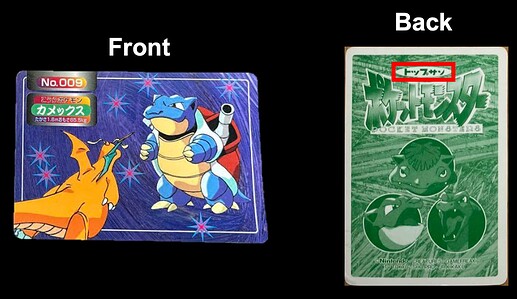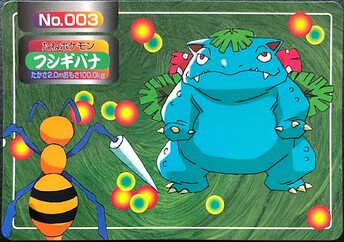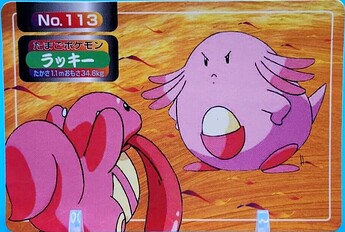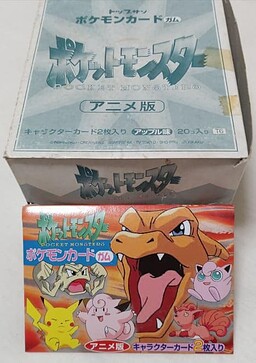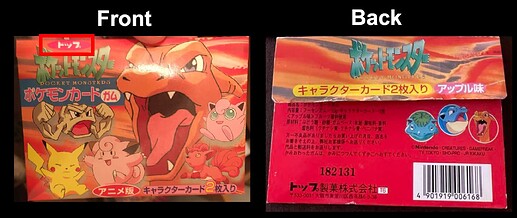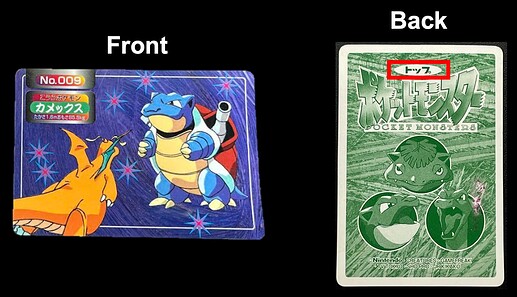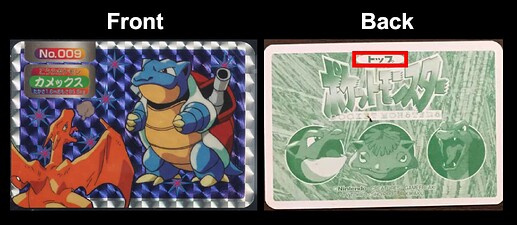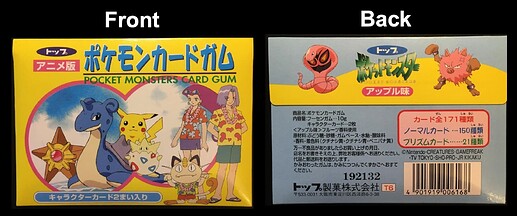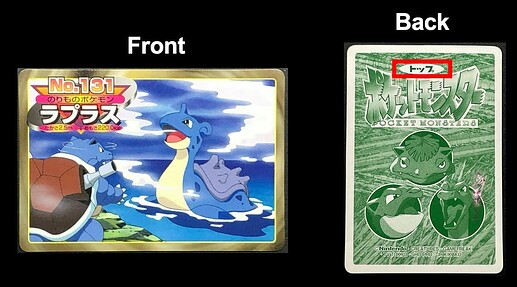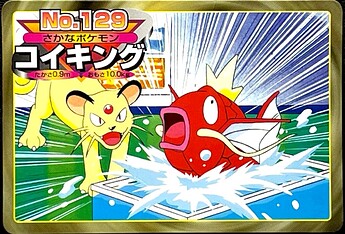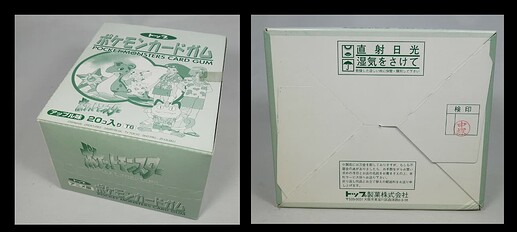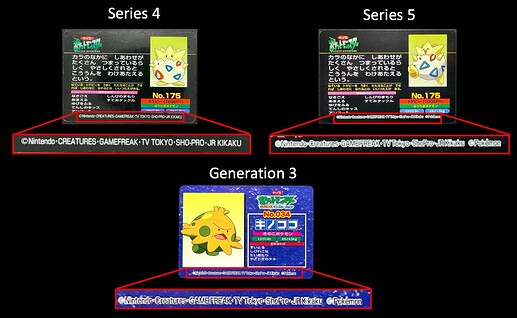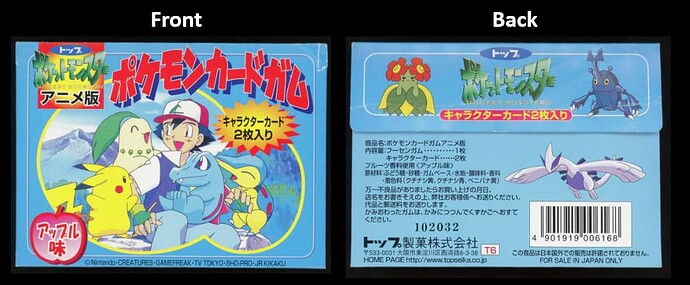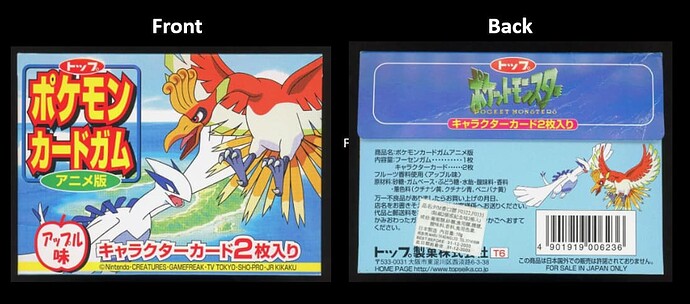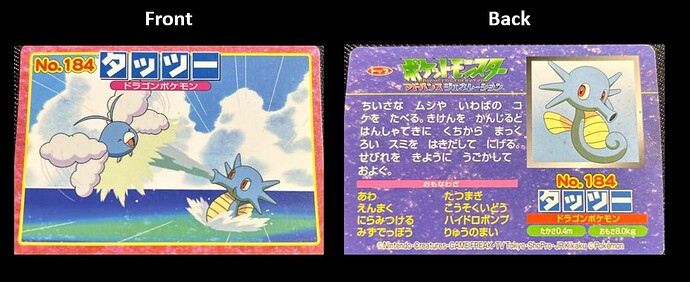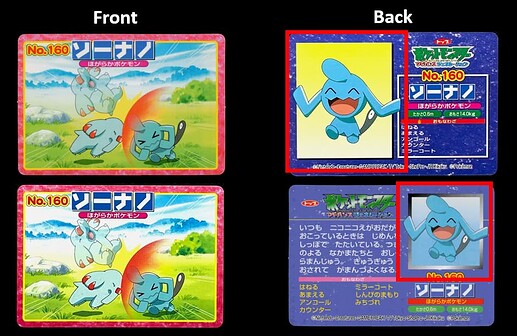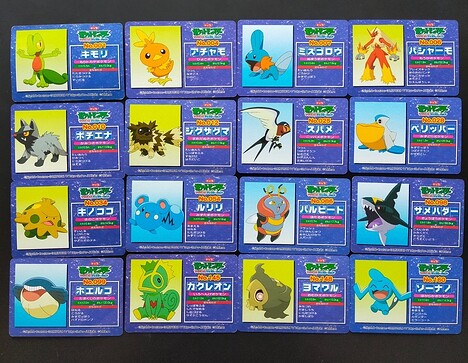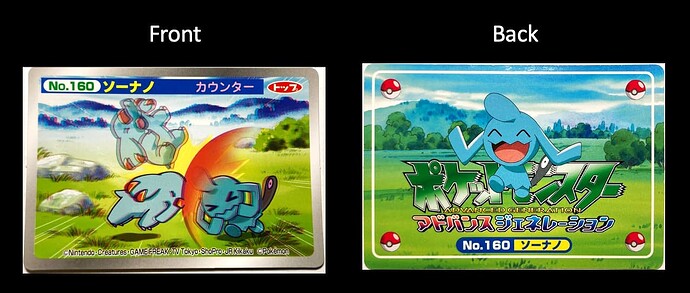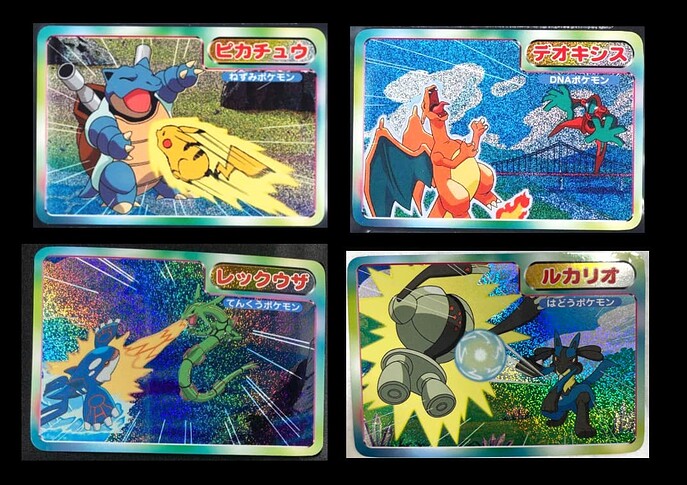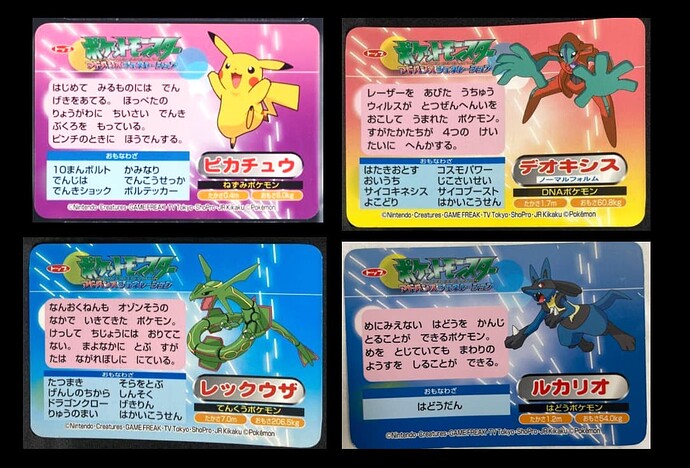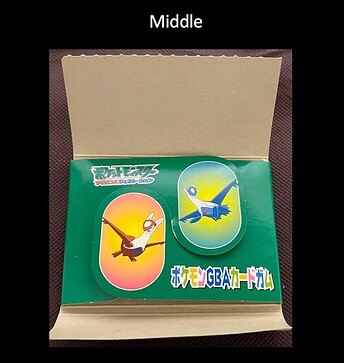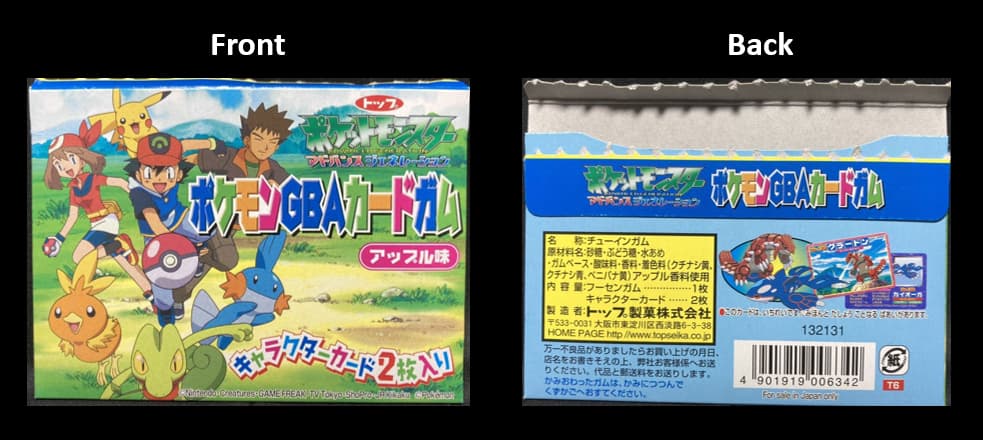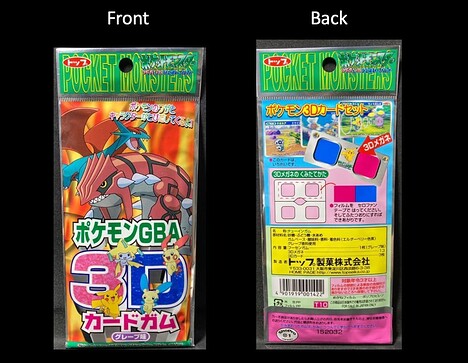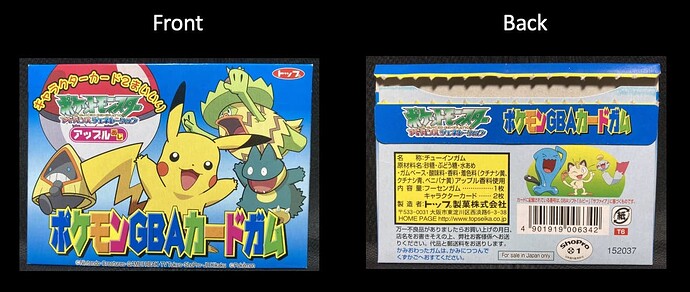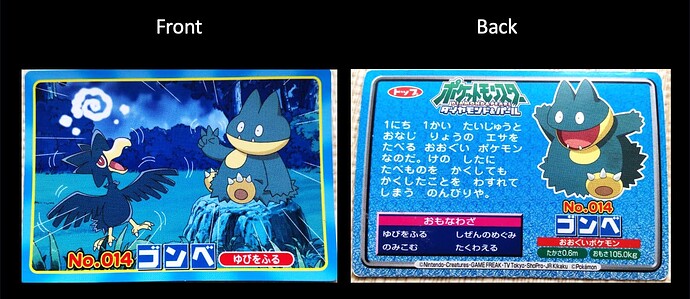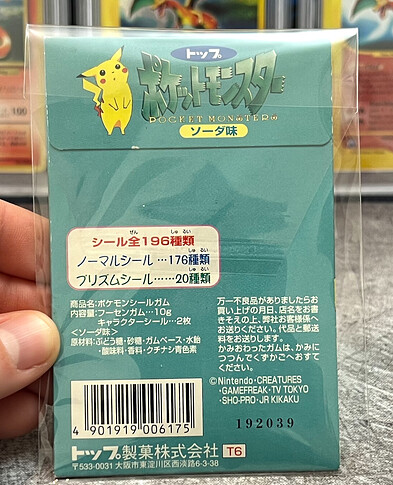Topsun/Top Battle Versus/VS Card Resource
Introduction
Welcome! I didn’t see any resources here for the Topsun/Top Battle Versus/VS sets, so I wanted to create this article to document, as best as possible, set lists and Pokemon appearances (for species collectors) for these cards. This article is currently a work in progress, as there are a lot of these sets with seemingly not that much information on them.
I’ve so far documented what I believe are mostly accurate set lists for the first three releases or “series” that cover all of the Generation I Pokemon. My sources for this information were Pokeboon’s article about Topsun cards, various threads existing on E4 (here, here, and here—big thanks to @cullers and @quuador for discussing some information about these sets before), and my own empirical data from scrutinizing listings on Mercari Japan. If you know of any incorrect information present in these lists or in the article, please let me know and I’d be happy to correct it.
Drafted set lists and Pokemon appearances for all series described below (so far) can be found here.
Additionally, a picture of every card for Series 1-9 can be found here.
With all that out of the way, let’s jump into it!
What are the Topsun/Top Battle Versus/VS Sets?
These aren’t your typical blue-back, green-back, no-number, first-Pokemon-cards-released (but not really) Topsun cards. These are your two-for-one Topsun bargains, as each card features, not one… but two Pokemon—locked in heated battle. There doesn’t seem to be an official name for these cards, but they are often referred to as “Topsun Versus/VS cards” or “Topsun Battle cards,” which is why I’ve tried to include all terminology in the naming of the set.
In the earlier series (i.e. Series 1 and 2, which will be elucidated below), the card design simply depicts two Pokemon standing opposed to each other, with one having its back facing you, reminiscent of in-game battles in the video games. But later versions (Series 3 and on) actually feature the Pokemon in action poses, using attacks that you might recognize from the games or anime. Contained within these Battle VS sets are some fan-favorite legendary matchups, like Blastoise vs Charizard, Rayquaza vs Groudon, and—everyone’s favorite—Seel vs Articuno.
I have seen these Battle VS sets cover up to Generation IV. I’m not sure if these sets exist for Generation V and beyond, but I may have just missed them for now.
Series 1 (Generation I)
Sources state that gum packs containing these cards were first released in 1997. Notably, these cards were distributed while Topsun was still utilizing the Topsun (トップサン) label. This label serves as a unique identifier of the Series 1 packs and cards, as Topsun changed their branding to Top (トップ) in all subsequent Battle VS set releases.
These cards feature two Generation I Pokemon posing on opposite ends of the card, with the putative “Attacking” Pokemon in the top right and the “Defending” Pokemon in the bottom left. In the top left corner, you’ll find some Pokedex information on the Attacking Pokemon: Pokemon type (e.g. Chansey, the “egg Pokemon”), name, height, and weight. In the absence of an official set list, I’ve designated each Pokemon’s Pokedex number as the card number, as each Pokemon only features as an attacker once. The Pokemon chosen to receive cards in the Series 1 release seem a bit random, but are generally focused in the earlier half of the Pokedex.
Each gum pack contains two of these cards, and in total, there are 52 cards to collect from this series.
Pictures of pack (note the “Topsun” label):
Pictures of example card (note the “Topsun” label):
The set also contains a few fun poses that bring a bit of charm and color into the somewhat plain design of the cards. Here are some of my favorites:
Possibly the only depiction of a bipedal Venusaur?
This Dugtrio concerned about having to face off with a menacing Venonat
Chansey giving you a stern look
I found a picture of the case with these packs, so I’ll share it here. It looks like 20 of the packs are available in each case.
Series 2 (Generation I)
As mentioned prior, from here on out, the packs and cards utilize the Top (トップ) label. This helps differentiate Series 1 and Series 2 cards, as the front is identical for those cards that are shared between the two series. However, it should be mentioned that, if you’re looking for these cards on online marketplaces, a majority of listings will still refer to these cards as “Topsun” cards despite the label change. Given this change, it’s not clear when the distribution year of this series was, as many refer to it (and Series 3) as 1997 Topsun cards, but in Pokeboon’s article about Topsun cards, it seems like the Top label might’ve been put into use in 1998. Thus, the year of set release is ambiguous.
Series 2 follows the same card layout as Series 1 and actually includes all of the Series 1 cards, but expands on the number of Attacking Pokemon featured, covering all Pokemon up to Seel. One major change, though, is the introduction of holo or prism foil cards. These foil cards feature the Attacking Pokemon opposing a different Pokemon than the regular card in the set.
The Series 2 set has 100 non-holo cards and 21 prism foil cards. Similar to Series 1, each gum pack contains two cards, with the chance of pulling a foil card being roughly 1 in 20 packs (quoting @cullers here).
Pictures of pack (note the “Top” label):
Pictures of example cards (note the “Top” label):
Original style:
Prism foil:
@cullers has a picture of an uncut sheet of prism foil cards here (from either Series 2 or 3).
Note: It is possible that not all 21 prism foil cards were released in this series, as there is no way of differentiating Series 2 and Series 3 cards (covered below).
Series 3 (Generation I)
For Series 3, the gum pack design changed. For some reason (which I do not know the answer to), these packs—but not the cards—are sometimes referred to as “Southern Island” packs, just in case you’re keen on searching for them.
Series 3 is interesting as it breaks away from the card layout used for Series 1 and 2 and introduces a gold-bordered “anime-like” versus card, with actual backgrounds and more dynamic posing. These “anime style” cards cover the remaining Pokemon that weren’t covered in Series 2 and are therefore focused on the latter half of the Pokedex (Dewgong and onwards). Additionally, these “anime style” cards become the norm for these Battle VS cards from here on out.
The backs of the Series 3 cards are the exact same as that of the Series 2 cards (this will be an important point touched on below). Given that Series 3 includes all of the Series 2 cards, the overlapped cards are seemingly indistinguishable, almost rendering the Series 2 release as obsolete.
Importantly, on the back of the pack, we finally have confirmation of how many cards are in the set! There are 150 “normal” set cards and 21 prism foil cards. These “normal” cards can be broken down into two different card designs (“original style” and “anime style”) and cover all Generation I Pokemon except Mew. Mew, instead, can be found as one of the prism foil cards. Thus, our Generation I Pokedex is complete! Each of these packs also comes with two cards, with the same 1 in 20 packs chance at a holo card (quoting @cullers again, here and here—I’m assuming the 1 in 40 he mentioned in the latter post is 1 holo per 40 cards, which is the same as 1 holo in 20 packs).
Pictures of pack:
Pictures of example “anime style” card (“original style” and prism foil cards are the same as Series 2):
One of my favorites is Magikarp performing the only attack it knows on a poor Persian:
Electrode’s face while exploding is also a good one:
This series is also the only series that I’ve found a pack opening for on Youtube, which can be found here.
I was able to find a picture of a case of these packs too, so I’ll include the picture here for sake of documentation. It looks like 20 of the packs are available in each case.
Lastly, as you can tell with the progression from Series 1 to Series 3, cards from previous series can be cannibalized into the newest series released. This is going to be seen again with the “anime style” cards in Series 3, as some (and possibly all) of these cards can be found in the Generation II Battle VS set(s), but with updated backs to reflect the change in card design (see below). Thus, only those with the plain green-back design are part of the earlier Series 3 release.
Series 4 (Generation II)
This series covers all of the generation II Pokemon (except Celebi) and features a new back side to the cards with additional information about the Attacking Pokemon. This series also appears to contain reprints of all of the generation I “anime style” cards in Series 3. The Series 3 and Series 4 cards can be easily differentiated by the reverse side of the card (see above). I can’t confirm that all the generation I cards were reprinted here, but I think it’s a reasonable guess. This series does feature one new generation I card, Mew, who was only available as a prism foil in Series 2 and 3.
Black Disc Variant (Generation II)
I was notified of this variant by @nidokingdom. He had noticed that some of the Johto cards has a different coloring in the design where the name and number are, with the disc design being solid black and white rather than having gradients of gray. The backs look identical.
We decided to put together a list of any cards we could identify as having this variant while browsing through online listings and whatever cards we had (a big thanks to nidokingdom, who put the majority of the list together). The list is currently at 50 cards, all of the new Johto pokemon. It is possible more exist, but just haven’t been discovered yet; but 50 cards in a set is also a nice, even number, so the list may be complete. With the copyright information looking identical to Series 4 (this is one main differentiating factor for Series 5—to be discussed below), I’m placing this mini-set’s release before Series 5. But whether this is the rookie Johto set (released prior to Series 4) or a reprint Johto set (released after Series 4) can’t be determined at this moment.
Note: The Johto set list may be more complicated, but some more data is needed. So far, nidokingdom and I have only been able to find black disc variants of the Ho-oh and the Skarmory VS card (I think it was these two), so it could be that some cards only have black disc variants instead of existing in both the black disc and gray disc sets. Further information is needed to determine whether this is true or not.
Series 5 (Generation II)
This series features all new cards, a majority of them from generation I. Cards from this series can be differentiated from Series 4 cards due to a subtle change on the back of the card. Where the copyrights are at the bottom, you’ll see that the font style differs between Series 4 and Series 5, with the latter adopting a style that would later be used for generation III VS cards also (see below). From my own experience trawling through listings on Mercari Japan, I believe the Series 5 cards were relatively short printed or not as readily available/not as popular, as the cards from this series do not seem to show up as often as Series 4 cards.
The set list here is really just a best guess from me based on any existing cards I could find a picture of. It seems like the intent of this series was to return to generation I to fill in the gaps for Pokemon that were missing an “anime style” card while integrating generation II Pokemon in the set (as the Defending Pokemon), but many generation I Pokemon are still left lacking a card in this style. A few generation II cards were also released in this series. Most notable is Celebi, which was the only generation II Pokemon missing from Series 4. Additionally, for whatever reason, Cleffa and Togepi also received new cards, with different Defending Pokemon than in Series 4.
Generation II Packs
I’m making this section to catalogue Top gum packs that likely contained the Generation II sets mentioned above. If each different release/set is matched to one pack art, these three pack arts would cover the three different releases mentioned above (i.e. Series 4, black disc variant, and Series 5). Unfortunately, nothing on these packs seems to indicate which release they may be associated with, so the pack arts will just stand alone for now.
Pack variant 1:
Pack variant 2:
Pack variant 3:
Series 6 (Generation III)
The Advanced Generation (or GBA) series covers the entire Hoenn pokedex, which features 202 total pokemon, including 135 new pokemon introduced in Ruby/Sapphire. Instead of the gold border of the Johto sets, the borders are now pink. In this set, there are a total of 210 cards though, as there are a couple variants for a few pokemon:
- Pikachu
- Castform (all forms: Normal, Sunny, Rain, Hail)
- Deoxys (three forms: Normal, Attack, Defense)
- Groudon
- Jirachi
Example of card design:
There is also some putative release information from an incomplete article on the set written by @pichufan. I’ll just quote what they posted here:
Additionally, an almost-complete card list with pictures can be found here (an incredibly useful resource pointed out by @Julius19). I used this resource to grab most of the pictures in my own list and also for quickly notating most of the matchups.
Portrait Variant (Generation III)
I haven’t seen mention of this in the other linked articles covering this set, but similar to the Johto set, there appears to be another variant for a few of the Advanced Generation cards too. This variant’s difference is found the back, where the portrait of the pokemon is much larger and found to the left of the card in the variant.
Like with the Johto set, I have no clue which of these designs came first, but this portrait variant seems to be much more limited. There appears to only be 16 cards total.
These do seem to a bit harder to find, but that may be due to the sheer difference in number in the releases. I was lucky to find a putative complete Advanced Generation pink-border set available on Yahoo Auctions, and in the listing, the seller seems to imply the 16 card set as coming before the main released set. But without confirmation of this, I’ll just leave it as a variant of the main set for now.
Series 7 (Generation III)
Have to start this one with a big shoutout to @Captain_Corsola who basically provided the set list that I compiled here. They have what they believe to be a complete set based on pure experience purchasing and trawling through listings and only finding duplicates. Though there may be a few odd-looking pockets in the set, we believe this to be the master list until evidence shows otherwise.
This set is one of the Top 3D gum sets and is basically a reprint set of Series 6 minus a large number of cards. Basically, all of the cards with Kanto/Johto pokemon as the Attacking Pokemon and a handful of Generation III pokemon are excluded from this set, leaving a total of 96 cards (slimmed down from 210). The set can be distinguished visually from the Series 6 set via obvious differences in card design: silver-gray borders; different graphic design for card #, pokemon name, etc.; and a picture modified for 3D viewing via 3D glasses. The backs of these cards also are devoid of information and simply depict an image of the Attacking Pokemon on top of an identical background.
Example of card design:
Note: Chronologically, this set may have been released much later than other Top VS sets, as the font for the card # is drastically different from even the Series 8 set, which still visually similar to previous sets. Also, despite the different card layout, these cards haven’t been added to the picture gallery, as they are just reprints.
Series 8 (Generation III)
Top finally decided to slim down their sets! The main set consists of 50 cards and is a later Advanced Generation set with green, instead of pink, borders and a plain white background on the back. The set primarily includes pokemon up to Generation III, but astute observers will notice a few Generation IV pokemon are included: namely, Munchlax, Bonsly, Weavile, Mime Jr., and Lucario. They seemed like somewhat random pokemon to me, but after a little bit of research, I found out that these Generation IV pokemon were introduced to fans prior to the actual release of Diamond/Pearl, mostly through the Pokemon: Lucario and the Mystery of Mew movie. It also seems somewhat tied to movie through Lucario’s nemeses in the set, as Lucario is portrayed attacking two of the Regis.
Example of card design:
I also included four unnumbered glitter foil cards as part of this set, but this is pure speculation as of now. Given that they’re unnumbered, it’s difficult to determine if they were actually part of the set and able to be pulled from the same gum packs (possibly as secret rares), or if there was some other distribution method. Either way, they are very likely connected to the Series 8 set, as the card design is almost identical and the border has a clear tinge of green. The backs of these cards are also similar but a lot more colorful.
Foil cards:
Generation III Packs
Like with the Generation II packs, I’m just cataloging packs containing the abovementioned Advanced Generation sets (and possibly the variant).
Series 6:
I don’t know how many packs arts exist, but if every release mentioned prior had a different pack art, I am possibly missing a couple. You can maybe assume a slight order for some of these, as one pack shows the Treecko on the back and another shows the Groudon, the latter of which would have been released later (if they went down the Hoenn pokedex in order).
Pack variant 1:
Pack variant 2:
Series 7:
3D Top gum pack:
Series 8:
I’m not sure if this pack is a Series 6 (pink border) or Series 8 (green border) Advanced Generation pack, but I’m putting it here because it features Munchlax, who was only introduced in the Series 8 set. (The opposite holds true here too, though, with Snorunt not featuring in this set.)
Pack art:
Series 9 (Generation IV)
This set is the actual start of the Generation IV or Diamond/Pearl set and is the last of the colored-border sets, with the border color being blue now. Most cards feature at least one Generation IV pokemon, but there are a few that still only feature Generation III or older pokemon. The card design now also includes the actual attack name, so I’ve included that as a column in the list. Nothing much else to describe for this set!
Example of card design:
And that concludes all I’ve put together for now!
Thanks for reading!
Update list:
7/19/2024: Added picture of case for Series 1; added information about Johto black disc variant; and added pictures of two Johto packs
7/23/2024: Added picture of third Johto series pack; added information on Advanced Generation (Generation III) sets (both Series 6 and Portrait variant); added pictures of two Advanced Generation packs
10/16/2024: Added information for Series 7, 8, and 9; added pictures of Series 7 and 8 packs; and added a picture of the middle part of Series 6 pack 1 (for any Latios/Latias collectors out there)

